The following article is based on sworn affidavit filed by Margaret Birrell in the Supreme Court of British Columbia, September 12, 2008 – View the Original Affidavit Here.
British Columbians have amnesia…
We fought and beat the the most discriminatory piece of proposed legislation against victim rights in BC history, the No-Fault ICBC Motor Vehicle Insurance Legislation, 23 years ago.
Now it’s back, disguised under the Orwellian “doublespeak” name: “Enhanced Care Coverage”.
207 non-profit coalition organizations were against No-Fault back when the fight started in 1996…

Margaret Birrell pictured in 2018
One of the leaders in the fight was Margaret Birrell, Executive Director of the BC Coalition of People with Disabilities (“BCCPD”). By mid-October of 1996, the Coalition Against No-Fault (“CANF”) had formed. CANF had seven founding members: Mothers Against Drunk Driving (Cdn. Soc.), the Surrey Community Crime Prevention Society, the BCCPD, the Trial Lawyers Association, the Injured Workers Human Rights Group, the BC Brain Injuries Association, and the Surrey Chapter of the Business and Professional Women’s Club of BC and the Yukon.
Birrell had been a candidate for the NDP in the 1996 election, an NDP leadership candidate in 1984, and a member of the executive committee of the NDP in or about 1994 through 1996, for a two year period. As such, she was in a privileged position with respect to her ability to put forth her views to the elected representatives forming the government at that time. She and other members of the CANF met in private with the Premier, the Attorney General, and many MLAs. It was clear that they were committed to introducing No-Fault insurance despite the arguments that were presented.
CANF decided that, despite their insider status, the only way they could effectively voice their concerns to the government was to unite people to present their message with one voice. They mounted a campaign with this objective.
The polling conducted by CANF showed that the public was largely uninformed about and unconcerned by No-Fault insurance. The first and main tasks were to focus the attention of the public on this issue and to educate them as to the negative effects of such a scheme. To this end, they issued press releases, appeared on radio and TV talk shows, organized rallies, and purchased advertising.
CANF sponsored one TV advertisement, and a number of radio advertisements.
However, the main vehicle was print advertising:
The Member Organizations that joined the No to No-Fault Coalition ended up being as follows:
- A.V. Arthritis Support Society
- Action Committee of People with Disabilities
- Active Retirees of Steelworkers of America – Vancouver
- Adult Learning Disabilities Association (ALDA)
- Advocacy Outreach Society
- Alberni Valley Head Injury Society
- Alzheimer Society of BC
- AN KO RS
- Arbutus Vocational Society
- Arthritis Society – Kelowna
- Battered Women’s Support Services
- BC Association for Community Living
- BC Blind Sports & Recreation Association
- BC Brain Injury Association
- BC Chamber of Commerce
- BC Chiropractic Association
- BC Citizens Against No-Fault Insurance
- BC Coalition of People with Disabilities
- BC Nurses’ Union
- BC Old Age Pensioners Organization
- BC People First Society
- BC Persons with AIDS Society
- BC Real Estate Association
- BC Schizophrenia Society
- BC Society of Oral Medicine Specialists
- BC Sports & Fitness Council for the Disabled
- BC Widow’s Association
- BC EADS
- Bosnian Community Living Association
- Boundary Women’s Resource Centre
- BPW Victoria
- Branching Out (Dawson Creek)
- Bulkley Valley AIDS Society
- Bulkley Valley Head Injury Association
- Burnaby Association for the Mentally Handicapped
- Burnaby Council of Women
- Burnaby Mental Wealth Society
- Business and Professional Women of BC & Yukon
- Business & Professional Women’s Club of BC & Yukon (Surrey Club)
- Campbell River Brain Injury Support Group
- Canadian Amputee Sports Association
- Canadian Council of the Blind (BC-Yukon Division)
- Canadian Hard of Hearing Association – BC Chapter
- Canadian Hard of Hearing Association – Kelowna
- Canadian Injured Workers Society
- Canadian Mental Health Association – East Kootenay
- Canadian Mental Health Association – B.C. Division
- Canadian National Institute for the Blind
- Canadian Taxpayers Federation
- Cedar Cottage Adult Day Care
- Central Interior Logging Association
- Central Island Legal Support Staff Association
- Central Okanagan Brain Injury Society
- Cerebral Palsy Association of BC
- Chetwynd Women’s Resource Society
- Chronic Pain Support Network
- City of Coquitlam – Mayor’s Committee for People with Disabilities
- CMHA- East Kootenay
- Coalition to Promote Interdependent Living
- Community Family Link Society of BC
- Community Living Society
- Comox Valley Head Injury Society
- Comox Valley Parkinson’s Support Group
- Comox Valley Women’s Resource Centre
- COMPACT (Committee to Promote Accessible Conventional Transit
- Consumer Development Project Penticton
- Contact Women’s Group Society
- Cowichan Valley Head Injury Support Group
- Cowichan Valley ILRC Society
- Craftworks Society
- Cranbrook Women’s Resource Society
- DAWN BC 1994 (DisAbled Women’s Network)
- DAWN Nanaimo (Disabled Women’s Network)
- DisAbled Women’s Network – Canada
- Downtown Eastside Women’s Centre
- Edmonds Seniors Society
- Ethical Environment Researchers Consultants
- f.a.p.g. (Federated Anti-Poverty Group)
- Fairview Management – Prince Rupert & Smithers
- Families As Support Teams Society
- Family Support Institute
- Fanny Bay OAPO
- Fifty 567 (Chevy) Club Vancouver & Area Chapter
- First Nations Council of Women
- Fort Nelson Women’s Resource Centre
- Fort St. John Head Injury Society
- Fort St. John Women’s Resource Centre
- Fraser Valley East Brain Injury Support Group
- Golden Women’s Resource Centre
- Greater Nanaimo Chamber of Commerce
- Greater Victoria Chamber of Commerce
- Handy Circle Promotions Society
- Head Start Program
- Improvement Group (Burnaby)
- Injured Workers’ Human Rights Group
- Interior Indian Friendship Society
- Kamploops Brain Injury Association
- Kamloops Business & Professional Women
- Kamloops & District Real Estate Association
- Kamploops Reporting Services
- Kate Booth House
- Kelowna Chamber of Commerce
- Kelowna Women’s Resource Centre
- Kent Street Senior Citizens’ Society
- Kinsman Rehabilitation Foundation of BC
- Kitimat Support Group
- Kwantlen University College Student Association
- Langley Aldergrove Brain Injury Support Group
- L’Arche – Comox Valley
- Law Students Association of UBC
- Local Union No. 97 of the International Association of Bridge, Structural and Ornamental Iron Workers
- Lower Mainland Brain Injury Association
- Mainstream Society for Integrated Living
- Maple Ridge Brain Injury Support Group
- Marusyk, Rick (Mayor, Port Moody)
- Massage Therapists’ Association of BC
- Mavis/McMullen Housing Society
- M.E. Myalgia Encephalomyelitis Society of BC
- Mission Association for Community Living
- Mood Disorders Association of BC
- Mothers Against Drinking Drivers (Canadian Society)
- MSA Society for Community Living
- Nanaimo Head Injury Society
- Nanaimo Independent Living Centre
- Nanaimo Widow’s Support Group
- Nanaimo Women’s Business Network
- Native Courtworker and Counseling Association of British Columbia (NCAA)
- New Focus Society – Quesnel BC
- New View Society
- New Westminster Brain Injury Support Group
- New Westminster Council of Women
- Newton Advocacy Group Support
- North Okanagan Handicapped Association
- North Okanagan/Shuswap Head Injury Society
- North Okanagan Youth & Familty Services Society
- North Shore Disability Resource Centre
- North Shore Family Support Group
- North Shore Parkinson’s Disease Support Group
- North Shore Women’s Centre
- Northwest Real Estate Board
- Pacific Transit Cooperative
- Peace Arch Community Services
- Penticton Italian Canadian Society
- People in Motion Kamloops
- People in Motion, Kelowna
- Planned Lifetime Advocacy Network
- Plexus Consulting
- Powell River Support Group
- Prince George AIDS Society
- Prince George Brain Injured Group Society
- Prince George Business & Professional Women’s Club
- Quesnel Women’s Resource Centre
- Ray-Cam Co-operative Centre
- RBO Architecture Inc.
- Reflexology Association of BC
- Relief Care Sitters
- Resource Centre for Independent Living
- Richmond Society for Community Living
- Richmond Women’s Resource Centre Association
- Rid Roads of Impaired Drivers
- Riverview Family Advocacy Group
- R.O.R.Y. (Kelowna Injured Workers Group)
- SAIL
- Salmon Arm Brain Injury Support Group
- SechelUSunshine Coast Brain Injury Support Group
- Sekora, Louis
- Senior Citizens Association of BC
- Senior Citizens Association – Branch #92
- SFU – Centre for Students with Disabilities
- South Granville Seniors Centre/Elders’ Network
- South Surrey/White Rock Women’s Place
- Sullivan, Sam (Councilor, City of Vancouver)
- Sunshine Coast People with Disabilities
- Surrey Chamber of Commerce
- Surrey Crime Prevention Society
- Surrey/Delta Brain Injury Support Group
- Surrey Rehabilitation Society
- Teamsters BC & Yukon Joint Council No. 36
- Terrace Women’s Centre
- Trail Disabled Needs
- Trial Lawyers Association of British Columbia
- Tri-Cities (Coquitlam, Port Coquitlam and Port Moody) Chamber of Commerce
- UclueleULong Beach Support Network
- Ukrainian Canadian Congress – Vancouver Branch
- Ukrainian Canadian Professional and Business Association – Vancouver Branch
- Ukrainian Women’s Association of Canada – Whalley Branch
- University of British Columbia Alma Mater Society
- University of Northern BC – Councilling Centre
- Valley View Health Group
- Vanouver Aboriginal Friendship Centre Society
- Vancouver Brain Injury Survivor Support Group
- Vancouver Island Real Estate Board
- Vancouver Resource Society
- Vancouver White Cane Club
- Vancouver Women’s Health Collective
- Vela Housing Society
- Vernon and District Womens’s Centre Society
- Victoria Status of Women Action Group
- Voice of the Cerebral Palsied of Greater Vancouver
- West End Senior’s Network Society
- West Kootenay Cerebral Palsy Association
- White Rock Brain Injury Support Group
- White Rock & District Council of Women
- Williams Lake Brain Injury Support Group
- Women Against Violence Against Women
- Women’s Resource Centre – Cowichan Valley
- Youth Community Outreach AIDS Society
At the defeat of No-Fault in June 1997…
…the government was forced to drop the issue. Before announcing this decision, the Premier’s office contacted Margaret Birrell, and she agreed that CANF would run advertisements thanking the Premier for making that decision, which CANF did.
The total value of the print advertising purchased by CANF during this campaign exceeded $250,000 (in 1997 dollars), with each advertisement costing between approximately $3,000 and $10,000 to run. Limits on the amounts they could spend in any particular two-month period could easily have derailed the campaign by killing its momentum. This was particularly true for the period from February 26 to April 26, 1997, as the Allen Committee which recommended the adoption of No-Fault insurance to the government made its report available on March 14, 1997. If they had not been able to effectively respond to this report, its conclusions might well have been adopted.
You’ll note in one of the aforementioned print ads, there were some suggestions to help shore up ICBC’s financial deficit without compromising victim rights. Those suggestions accompanied by the annual savings were as follows:
- Accident Prevention – $200 Million
- Mandatory Mediation – $130 Million
- Enhanced Claims Management (Fraud Prevention) – $100 Million
- Anti-Theft Measures – $26 Million
- Increase Small Claims Court Limit – $37 Million
- More ICBC Defence Done In-House – $11 Million
- Improved Internal Efficiencies – $33 Million
- Use Premium Tax to Pay for Road Safety – $30 Million
- Revenue from Traffic Fines – $100 Million
- Private Insurance Profit Equalization – $33 Million
Total Annual Savings = $700 Million
As a result of the No-Fault scheme failing, it ended up resulting in some of these other proactive measures, namely the Graduated Licensing Program the following year in 1998. The implementation of the GLP turned a projected $2.4 Billion ICBC deficit into $600 Million profit and a 5-year rate freeze. This also likely saved countless lives in the process- root cause prevention, rather than sacrificing victim rights!
Fast forward to 2020: under the new “Enhanced Care Model” AKA No-Fault, the injured will not receive pain & suffering compensation when they are the victims of a motor vehicle accident. They will not have access to justice with legal representation. If they were to hire a lawyer to help them with the newly proposed labyrinth dispute resolution process, they would be forced to pay for this out of their own pocket, which reserves this only for the wealthy. Accordingly, No-Fault discriminates against people socioeconomically. We advised Attorney General, Minister David Eby of this and more in a March 9th, 2020 letter.
Not only does it discriminate socioeconomically, it discriminates against women. As we advised Mitzi Dean, Parliamentary Secretary for Gender Equity, women are 73% more likely to be seriously injured in a frontal car collision than that of men, and are 17% more likely to be killed. (Source: Keith Barry, ConsumerReports.org October 23, 2019).
No-Fault discriminates against race. The motor vehicle fatality rate is 248% higher for that of First Nations, than that of the general population. (Source: Vision Zero, BC’s Road Safety Strategy 2016).
No-Fault discriminates against the disabled who do not have an income. They will receive no compensation for their diminished quality of life, or their pain & suffering. Their life challenges will become that much harder and this will not be recognized, or dignified under the law.
No-Fault discriminates by age. When seniors and children are a victim in a motor vehicle accident, they do not have an income that is replaced and will not receive pain & suffering damages for their diminished quality of life. They will suffer through their injuries with no dignity, or acknowledgement under the law of the wrongful act that they endured.
No-Fault discriminates against Students, Caregivers, and the Unemployed. While these individual’s labour is not able to be immediately measured by a full time income, being a victim in a motor vehicle accident still impacts their life, ability to be productive, and surely impacts future earning potential. They too will also receive no compensation for their diminished quality of life, or their pain & suffering.
Individuals will be denied psychological control over their lives and the dignity of being able to direct their own care.
When a person is put on subsistence, there is focus on the pain associated with their injury and trauma. Even in the event of undertaking a lawsuit for personal injury (as our law presently allows prior to no-fault) these symptoms persist. It is common after a claim, or lawsuit is concluded by settlement, or verdict for the excessive thoughts, feelings and behaviours relating to the physical symptoms to clear, and the person is much more empowered to move on with their lives.
We’ve discussed the psychological impacts much more in detail in an article titled: ‘‘Government Proposes End to Pain & Suffering Compensation and Access to Justice; Replacing it With Victim Welfare Program‘.
What’s being done in other jurisdictions?
The truth is, not many of the other provinces are doing that great of a job, but most are far better than the proposed No-Fault scheme in BC.
A 2017 report by University of Ottawa Economics Professor Rose Anne Devlin, ‘Comparing Insurance Across Canada‘, provides a detailed analysis. We dive further into that analysis in our commentary piece: ‘Comparing Auto Insurance Regimes Across Canada to British Columbia‘.
The biggest comparison from that analysis when looking at the future of automobile insurance in BC under No-Fault would be Manitoba. Our easternmost prairie province has a No-Fault regime with a public insurer that was still more expensive than ICBC, as of 2017 for the average driver utilizing the same insurance.
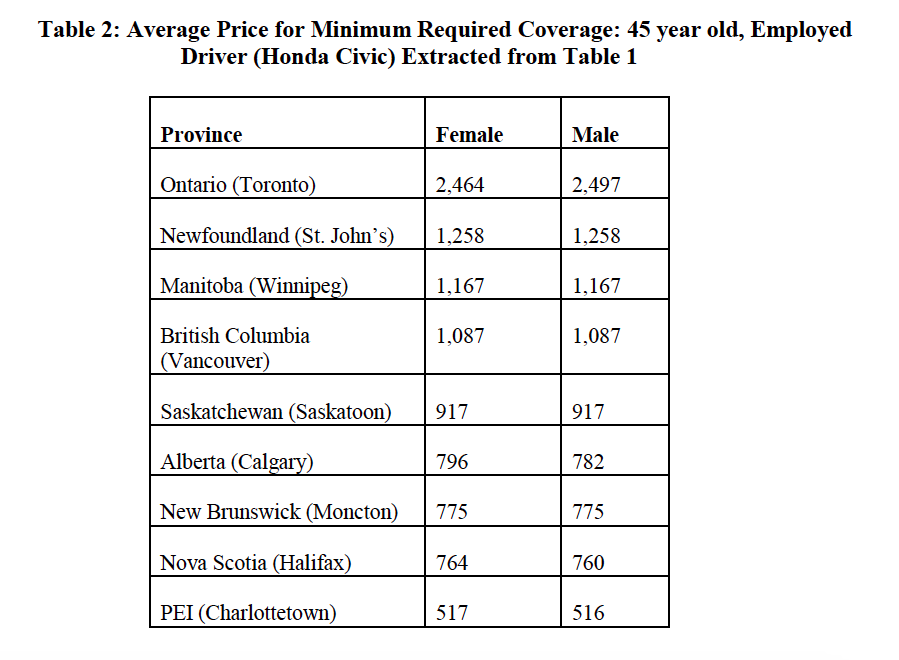
Automobile Insurance Pricing Across Canada Circa 2017
Manitoba also has double the motor vehicle casualty rate as British Columbia, as per the Government of Canada Traffic Statistics website.

Canadian Traffic Casualty Rates – 2018
One might speculate that No-Fault might actually make our roads less safe without having general deterrence mechanisms and incentives in place to make its roads safer for motorists, passengers, pedestrians, and cyclists alike!
One might also argue that if the No-Fault scheme is implemented in BC, policy holders may save money on their premiums at first. However, with ICBC having nearly 6,000 employees, roughly twice the amount of staff compared to any other Canadian private insurance provider its size, its high overhead directly inflates auto insurance premiums. Many other insurance providers provide the same services more efficiently across the country. Consequently, the government’s inability to restructure ICBC, as well as lacking focus on root cause prevention as per the 2016 Vision Zero Road Safety Strategy, will inevitably lead us down the road to the same financial problems years from now. Except at that time, there won’t be anymore victim rights to take away to counterbalance poor decision making and bad governance.
Why No-Fault instead of focusing on root-cause prevention like the Graduated Licensing Program introduction in 1998?
In 2015, when the UN developed a global road safety strategy, Canada signed on as a collaboration partner. BC, developed a plan based on this called Vision Zero. The United Kingdom cut its accident rate to half the rate per capita of BC by having previously implemented these same strategies. Source: Reported road casualties in Great Britain: 2018 annual report.
28 key recommendations were made in the PROVINCIAL HEALTH OFFICER’S REPORT ON ROAD SAFETY Presented By: Drs. Perry Kendall, Provincial Health Officer and Bonnie Henry, Deputy Provincial Health Officer on March 31, 2016.
We presented these recommendations in an article titled ‘A Strategic Approach to Road Safety – How to Shore Up ICBC Financially by Focusing on Root Cause Prevention‘ as an alternative to the proposed No-Fault insurance scheme announced in February 2020. An approach focused on root cause prevention of accidents would be a win-win for the government and the province. The proposed No-Fault is a win for the government, and a huge loss for the victims of motor vehicle accidents.
Here are the reports related to focusing on motor vehicle accident prevention in Canada and more specifically British Columbia:
BC’s Road Safety Strategy 2015 and Beyond
BC Communities Road Safety Survey
Canada’s Road Safety Strategy 2025
Moving to Vision Zero: Road Safety Strategy Update and Showcase of Innovation in British Columbia
BC Provincial Health Officer’s Report on Road Safety
What are some experiences that people endure under No-Fault?
You can Google and find a number of horror stories. Here is one we found involving Saskatchewan’s public insurer SGI utilizing the No-Fault model.
Mother ‘devastated’ daughter’s claim denied by insurance.
Here is one comment under an article about No-Fault in BC posted on Facebook…
What about wrongful deaths under No-Fault?
The BC Wrongful Death Law Reform Society, under the campaign dubbed ‘In Their Name‘, is focused on representing families who’ve lost a loved one to wrongful death and driving legislative modernization so that all of BC’s citizens have dignity, value, and protection under the law.
The provincial government has done absolutely nothing to address the fact that BC is the last of all provinces yet to modernize its wrongful death laws. Those who do not have an income plus dependents have no worth under the law. Everyone else, especially vulnerable groups such as the children, seniors, and the disabled, are completely worthless under this antiquated and discriminatory legislation. All of the other provinces, as well as the Yukon, have modernized their wrongful death legislation, in many cases years ago.


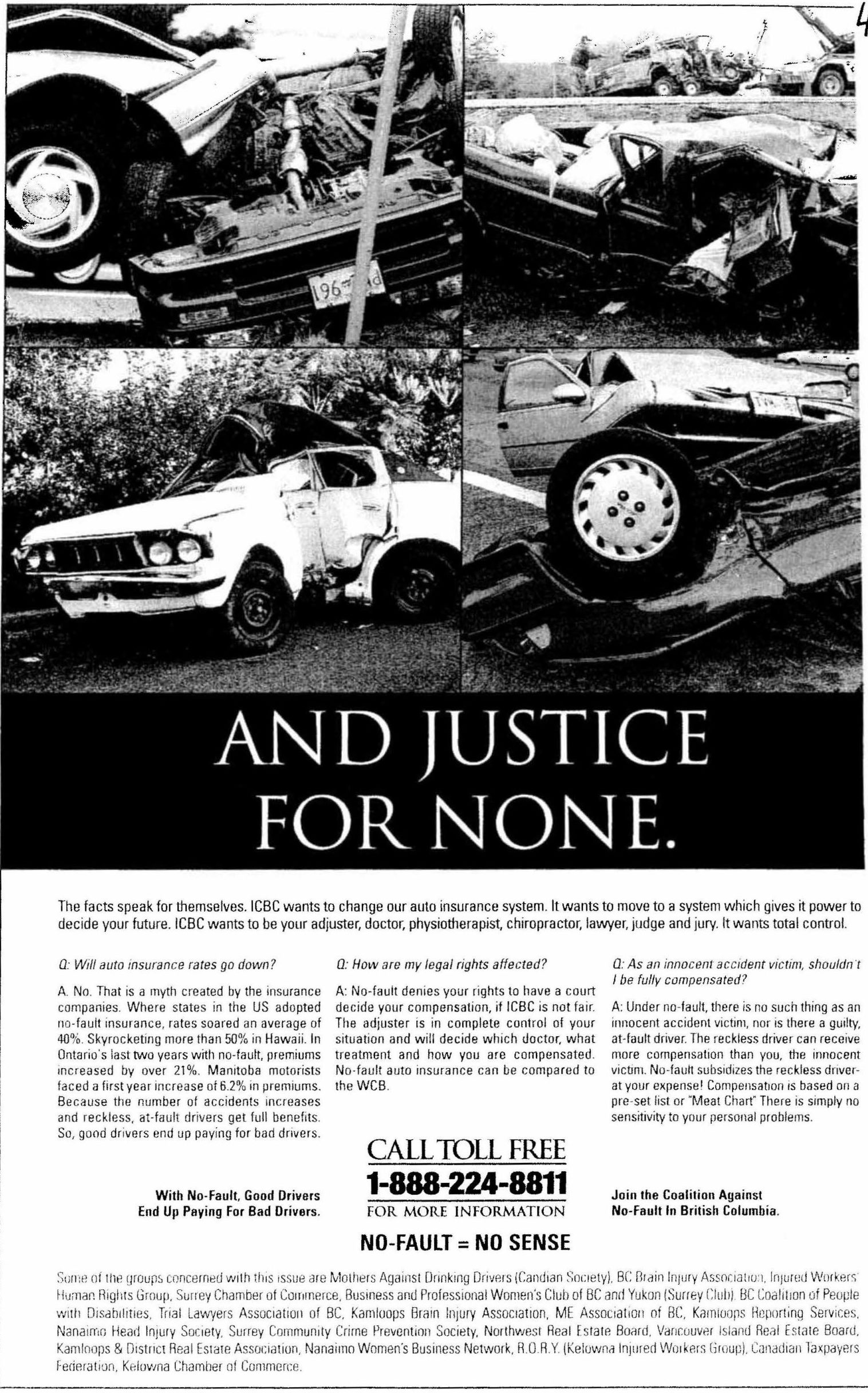
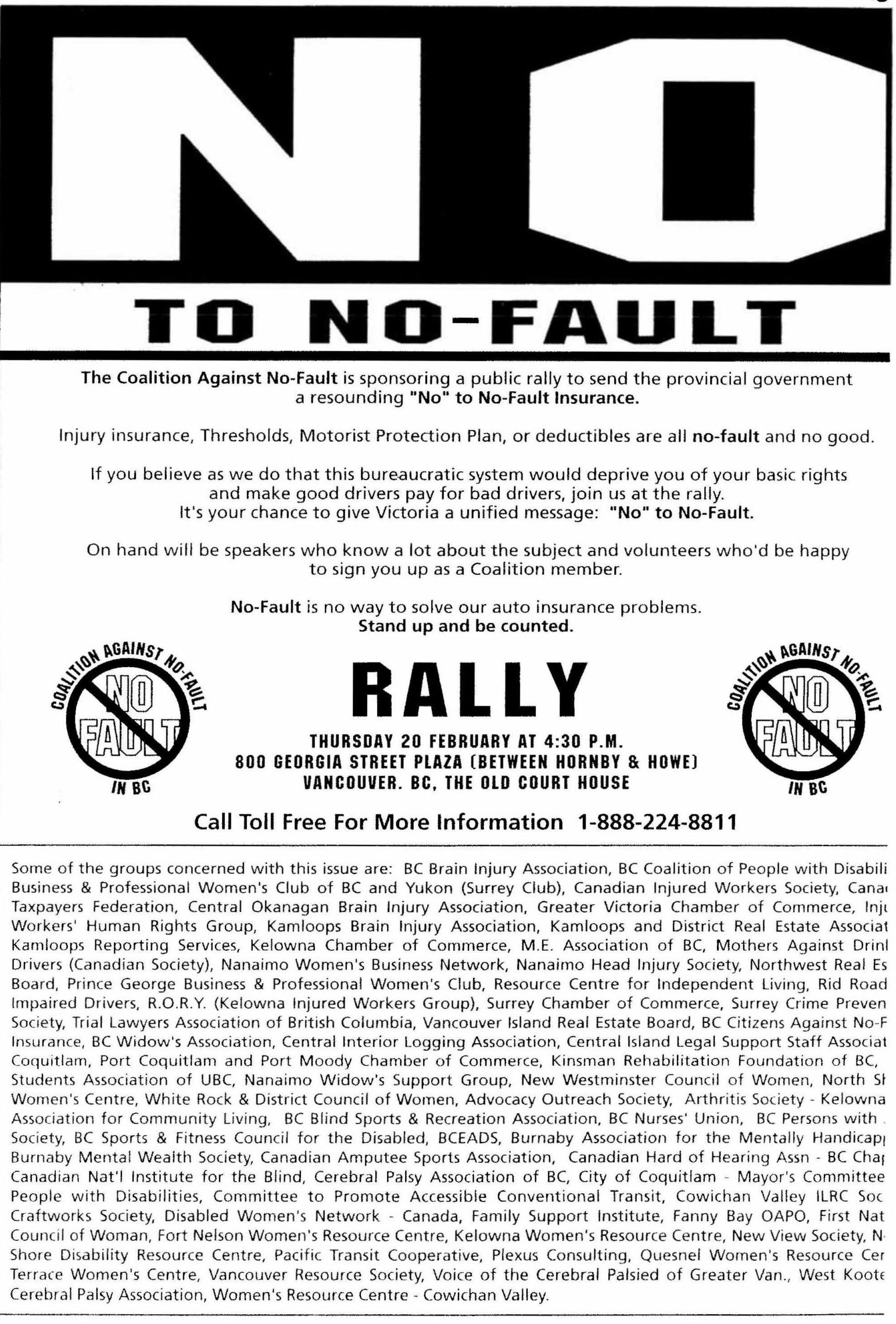
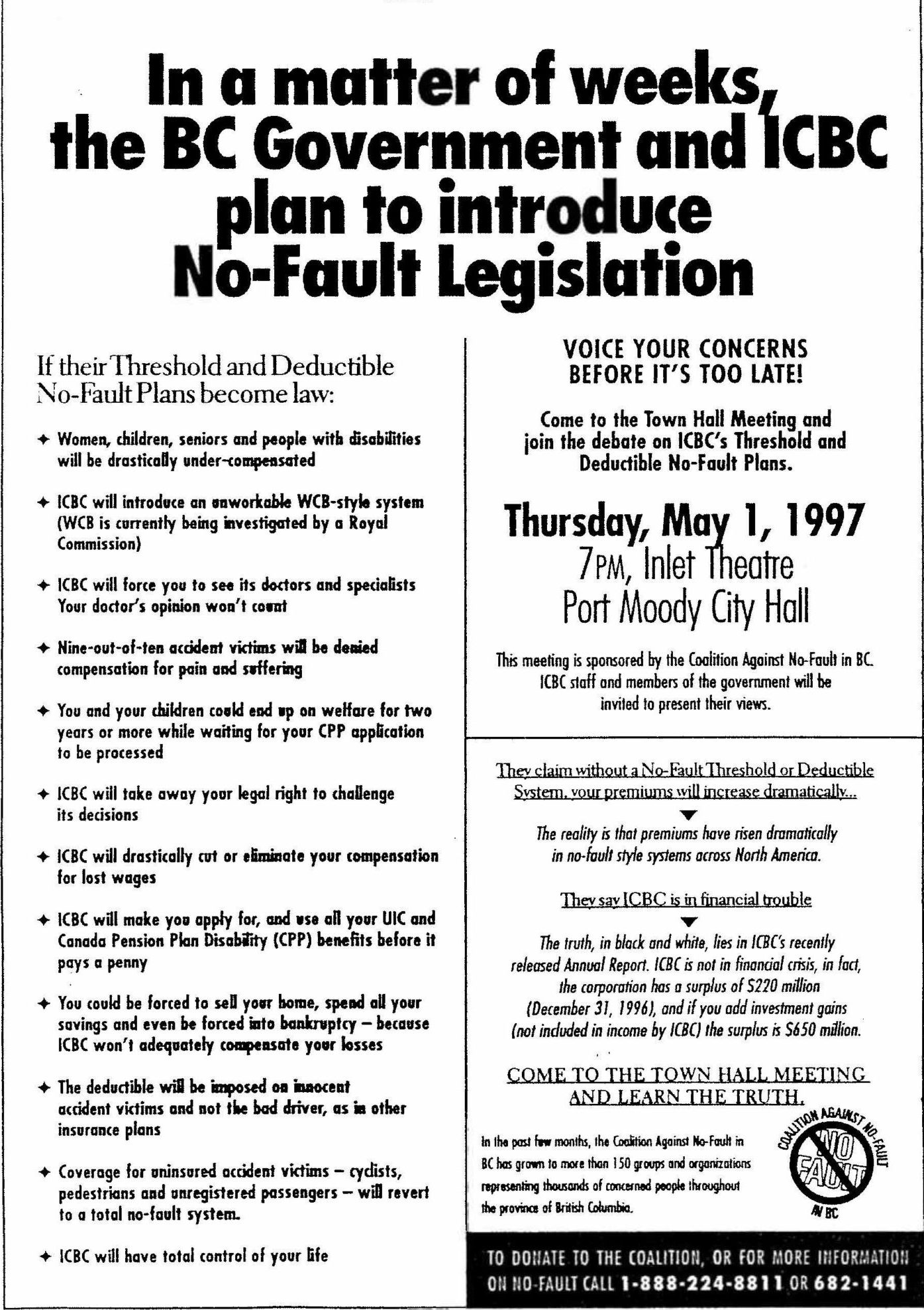
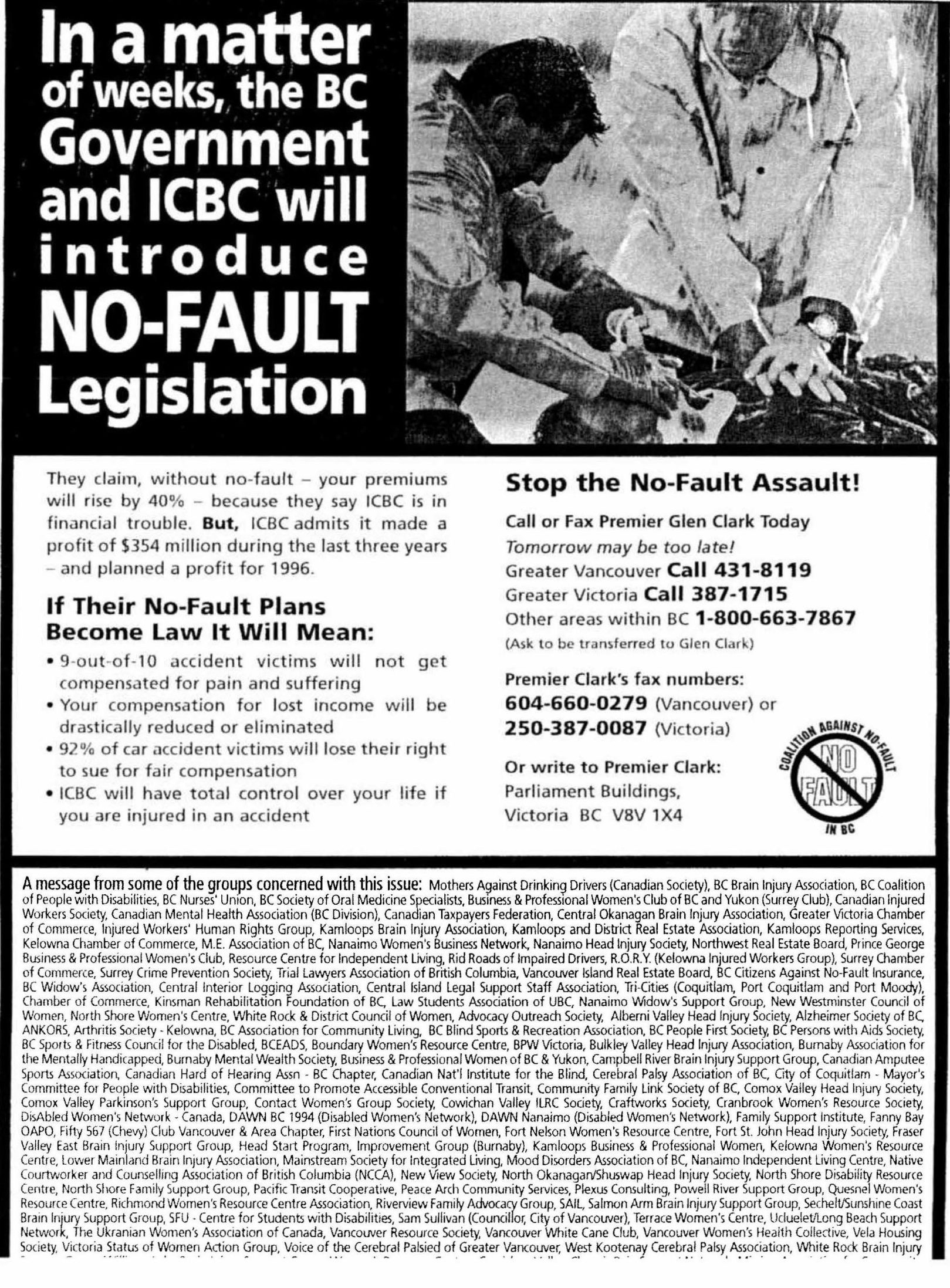

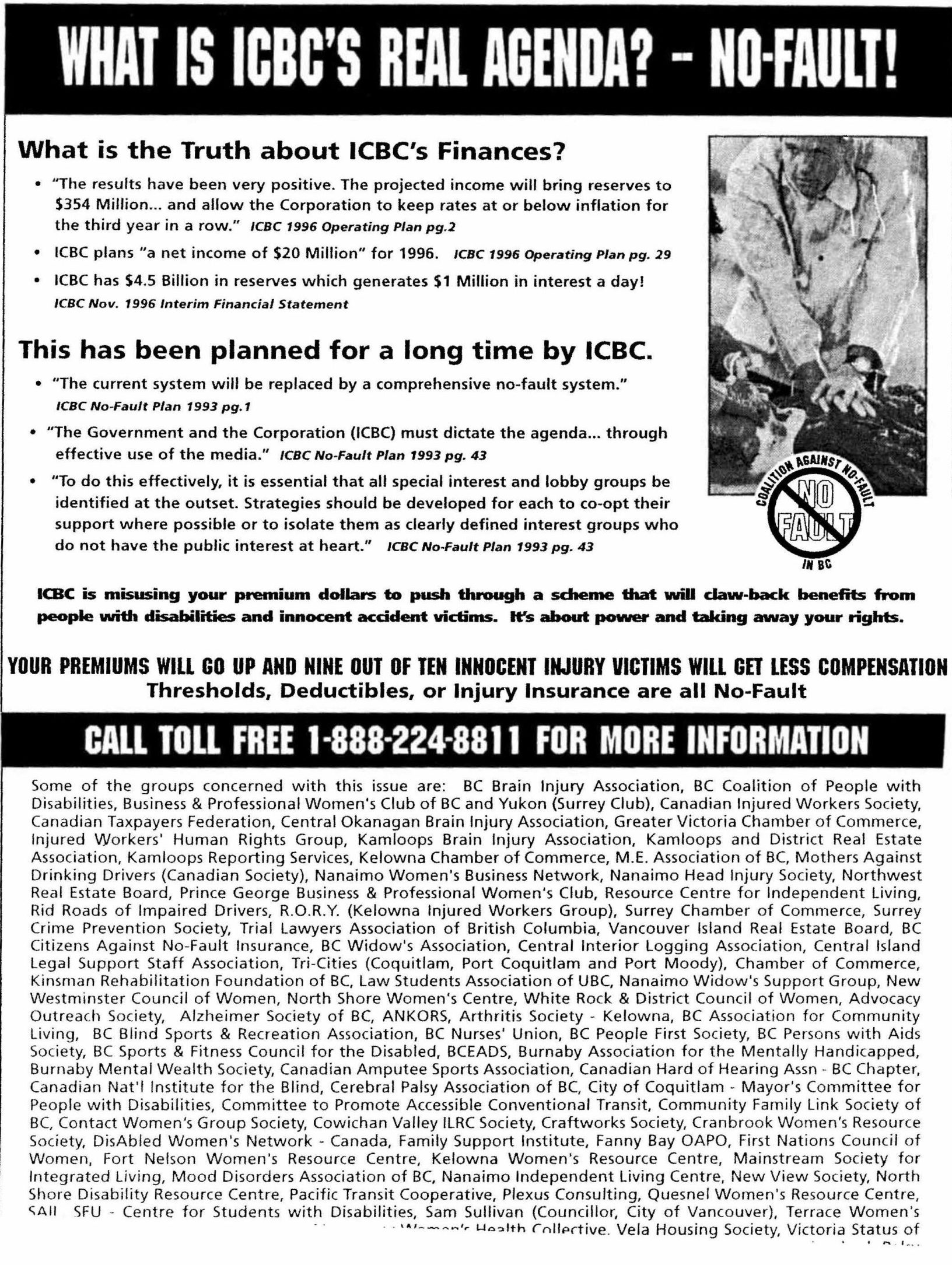
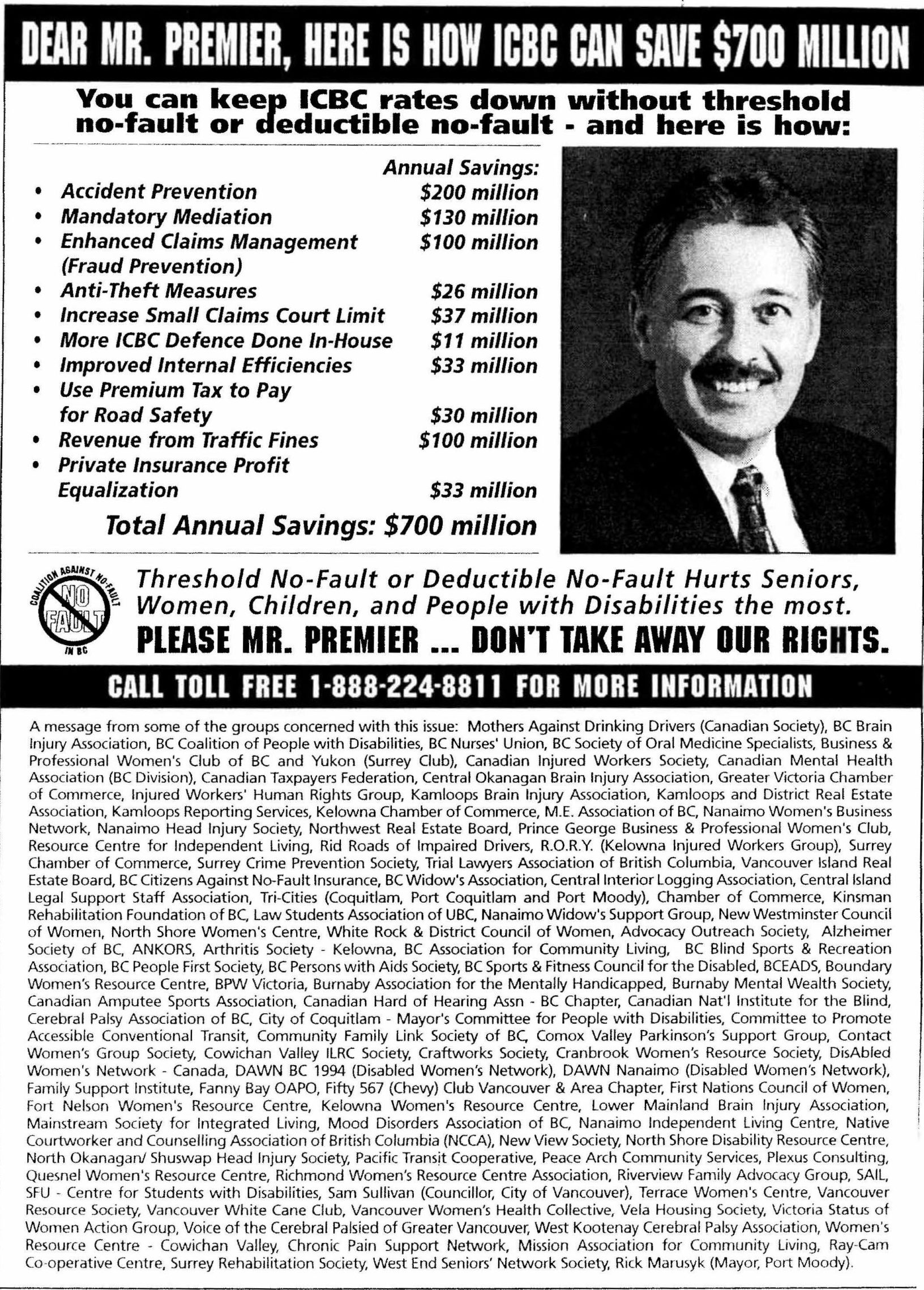
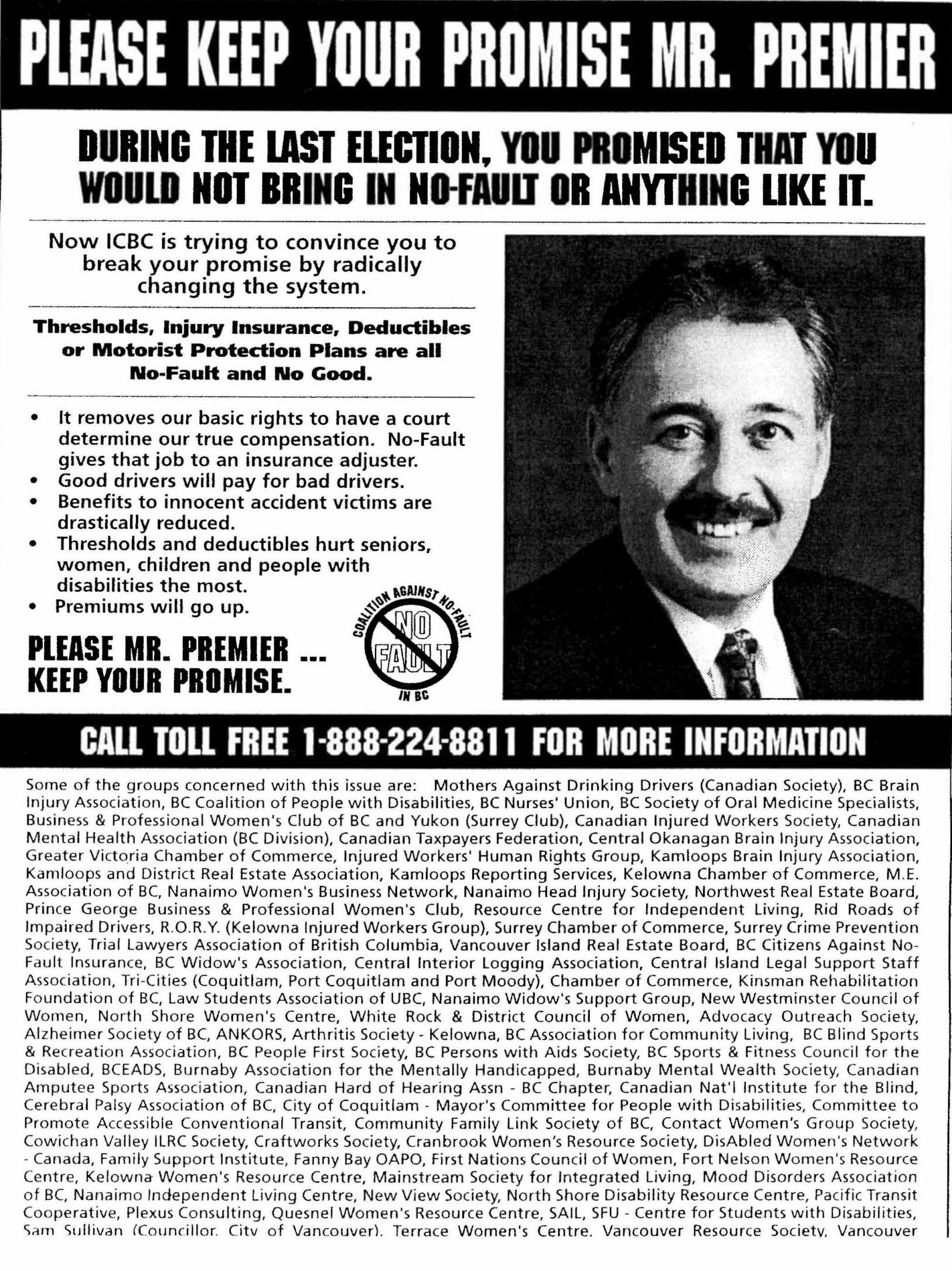
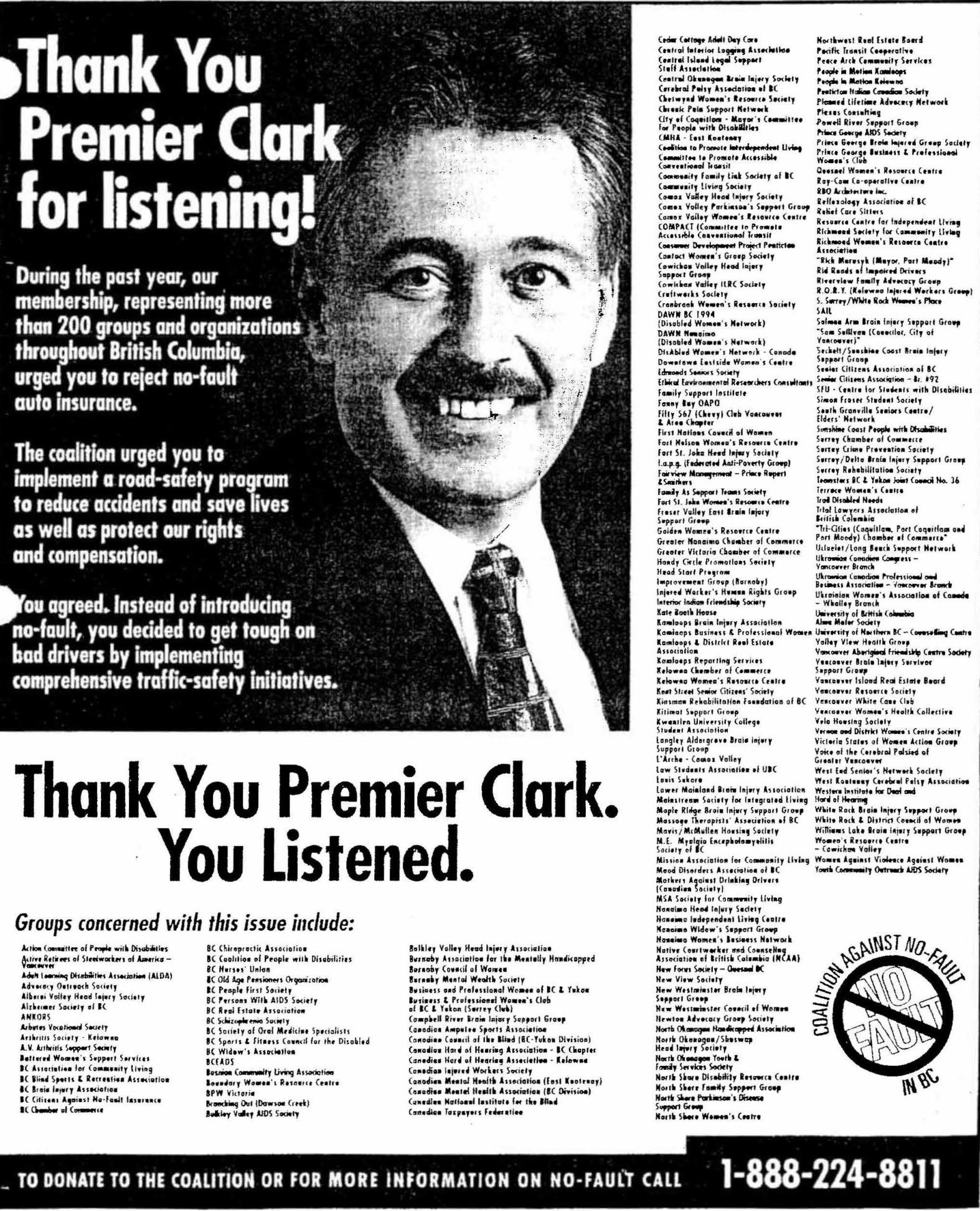
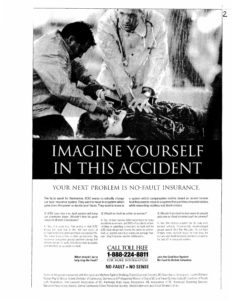
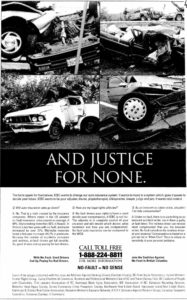


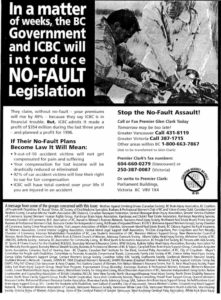
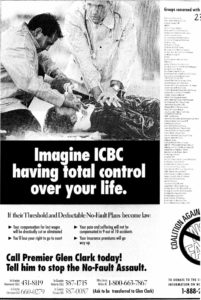
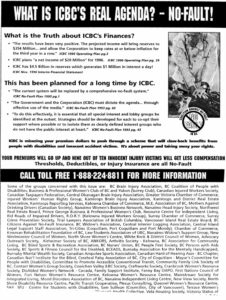

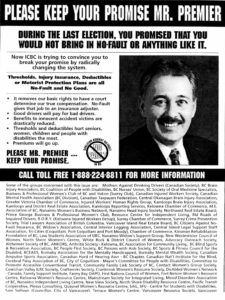


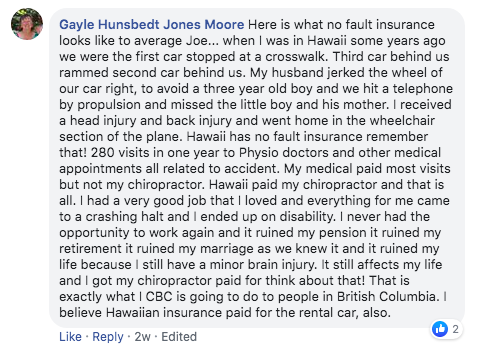
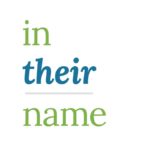 ‘In Their Name’ is the campaign of ‘The BC Wrongful Death Law Reform Society’ – a BC registered non-profit organization comprised of volunteer families who have lost a loved one to wrongful death in BC and were denied access to justice. In response to the biggest human rights issue facing the province today, our goal is to modernize British Columbia’s antiquated wrongful death legislation, which predates confederation (1846). Under current legislation, the value of a human life is measured only by the deceased’s future lost income, so long as they had dependents.
‘In Their Name’ is the campaign of ‘The BC Wrongful Death Law Reform Society’ – a BC registered non-profit organization comprised of volunteer families who have lost a loved one to wrongful death in BC and were denied access to justice. In response to the biggest human rights issue facing the province today, our goal is to modernize British Columbia’s antiquated wrongful death legislation, which predates confederation (1846). Under current legislation, the value of a human life is measured only by the deceased’s future lost income, so long as they had dependents.